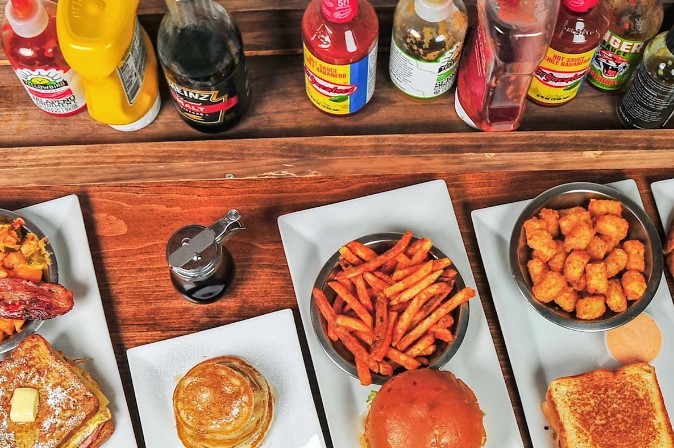Tumor organoid biobank-new platform for medical research

Pan, W. et al. The molecular subtypes of triple negative breast cancer were defined and a ligand-receptor pair score model was constructed by comprehensive analysis of ligand-receptor pairs. Front. Immunol. 13, 982486. https://doi.org/10.3389/fimmu.2022.982486 (2022).
Wang, X. et al. Cross-talk of four types of RNA modification proteins with adenosine reveals the landscape of multivariate prognostic patterns in breast cancer. Front. Genet. 13, 943378. https://doi.org/10.3389/fgene.2022.943378 (2022).
Sweed, D. et al. The clinicopathological and prognostic factors of hepatocellular carcinoma: A 10-year tertiary center experience in Egypt. World J. Surg. Oncol. 20, 298. https://doi.org/10.1186/s12957-022-02764-2 (2022).
Cheng, C., Feng, X., Li, X. & Wu, M. Robust analysis of cancer heterogeneity for high-dimensional data. Stat. Med. 41, 5448–5462. https://doi.org/10.1002/sim.9578 (2022).
Abdelraouf, E. M. et al. Annexin A2 (AnxA2) association with the clinicopathological data in different breast cancer subtypes: A possible role for AnxA2 in tumor heterogeneity and cancer progression. Life Sci. 308, 120967. https://doi.org/10.1016/j.lfs.2022.120967 (2022).
Elbadawy, M. et al. Anti-cancer activity of amorphous curcumin preparation in patient-derived colorectal cancer organoids. Biomed. Pharmacother. 142, 112043. https://doi.org/10.1016/j.biopha.2021.112043 (2021).
Elbadawy, M. et al. Anti-tumor effect of trametinib in bladder cancer organoid and the underlying mechanism. Cancer Biol. Ther. 22, 357–371. https://doi.org/10.1080/15384047.2021.1919004 (2021).
Boj, S. F. et al. Organoid models of human and mouse ductal pancreatic cancer. Cell 160, 324–338. https://doi.org/10.1016/j.cell.2014.12.021 (2015).
Clevers, H. Modeling development and disease with organoids. Cell 165, 1586–1597. https://doi.org/10.1016/j.cell.2016.05.082 (2016).
Lancaster, M. A. & Huch, M. Disease modelling in human organoids. Dis. Model Mech. 12, dmm039347. https://doi.org/10.1242/dmm.039347 (2019).
Huang, Y. et al. Air pollution, genetic factors, and the risk of lung cancer: A prospective study in the UK biobank. Am. J. Respir. Crit. Care Med. 204, 817–825. https://doi.org/10.1164/rccm.202011-4063OC (2021).
Jacob, F. et al. A patient-derived glioblastoma organoid model and biobank recapitulates inter- and intra-tumoral heterogeneity. Cell 180, 188-204.e22. https://doi.org/10.1016/j.cell.2019.11.036 (2020).
Said, M. A., Verweij, N. & van der Harst, P. Associations of combined genetic and lifestyle risks with incident cardiovascular disease and diabetes in the UK Biobank study. JAMA Cardiol. 3, 693–702. https://doi.org/10.1001/jamacardio.2018.1717 (2018).
Muller, D. C., Johansson, M. & Brennan, P. Lung cancer risk prediction model incorporating lung function: Development and validation in the UK Biobank prospective cohort study. J. Clin. Oncol. 35, 861–869. https://doi.org/10.1200/JCO.2016.69.2467 (2017).
Wang, Q. L., Ness-Jensen, E., Santoni, G., Xie, S. H. & Lagergren, J. Development and validation of a risk prediction model for esophageal squamous cell carcinoma using cohort studies. Am. J. Gastroenterol. 116, 683–691. https://doi.org/10.14309/ajg.0000000000001094 (2021).
Takahashi, Y. et al. A refined culture system for human induced pluripotent stem cell-derived intestinal epithelial organoids. Stem Cell Rep. 10, 314–328. https://doi.org/10.1016/j.stemcr.2017.11.004 (2018).
Noguchi, T. K. et al. Generation of stomach tissue from mouse embryonic stem cells. Nat. Cell Biol. 17, 984–993. https://doi.org/10.1038/ncb3200 (2015).
McCracken, K. W., Howell, J. C., Wells, J. M. & Spence, J. R. Generating human intestinal tissue from pluripotent stem cells in vitro. Nat. Protoc. 6, 1920–1928. https://doi.org/10.1038/nprot.2011.410 (2011).
Sato, T. et al. Single Lgr5 stem cells build crypt-villus structures in vitro without a mesenchymal niche. Nature 459, 262–265. https://doi.org/10.1038/nature07935 (2009).
van de Wetering, M. et al. Prospective derivation of a living organoid biobank of colorectal cancer patients. Cell 161, 933–945. https://doi.org/10.1016/j.cell.2015.03.053 (2015).
Vlachogiannis, G. et al. Patient-derived organoids model treatment response of metastatic gastrointestinal cancers. Science 359, 920–926. https://doi.org/10.1126/science.aao2774 (2018).
Fujii, M. et al. A colorectal tumor organoid library demonstrates progressive loss of niche factor requirements during tumorigenesis. Cell Stem Cell 18, 827–838. https://doi.org/10.1016/j.stem.2016.04.003 (2016).
Kraiczy, J. et al. DNA methylation defines regional identity of human intestinal epithelial organoids and undergoes dynamic changes during development. Gut 68, 49–61. https://doi.org/10.1136/gutjnl-2017-314817 (2019).
Zachos, N. C. et al. Human enteroids/colonoids and intestinal organoids functionally recapitulate normal intestinal physiology and pathophysiology. J. Biol. Chem. 291, 3759–3766. https://doi.org/10.1074/jbc.R114.635995 (2016).
Saksena, S. Nonpharmacologic therapy for tachyarrhythmias: The tower of Babel revisited?. Pacing Clin. Electrophysiol. 11, 93–97. https://doi.org/10.1111/j.1540-8159.1988.tb03932.x (1988).
Xu, R., Zhou, X., Wang, S. & Trinkle, C. Tumor organoid models in precision medicine and investigating cancer-stromal interactions. Pharmacol. Ther. 218, 107668. https://doi.org/10.1016/j.pharmthera.2020.107668 (2021).
Kim, J., Koo, B. K. & Knoblich, J. A. Human organoids: Model systems for human biology and medicine. Nat. Rev. Mol. Cell Biol. 21, 571–584. https://doi.org/10.1038/s41580-020-0259-3 (2020).
Dekkers, J. F. et al. Characterizing responses to CFTR-modulating drugs using rectal organoids derived from subjects with cystic fibrosis. Sci. Transl. Med. 8, 344ra84. https://doi.org/10.1126/scitranslmed.aad8278 (2016).
Sugimoto, S. et al. Reconstruction of the human colon epithelium in vivo. Cell Stem Cell. 22, 171-176.e5. https://doi.org/10.1016/j.stem.2017.11.012 (2018).
Driehuis, E., Kretzschmar, K. & Clevers, H. Establishment of patient-derived cancer organoids for drug-screening applications. Nat. Protoc. 15, 3380–3409. https://doi.org/10.1038/s41596-020-0379-4 (2020).
Maenhoudt, N. et al. Developing organoids from ovarian cancer as experimental and preclinical models. Stem Cell Rep. 14, 717–729. https://doi.org/10.1016/j.stemcr.2020.03.004 (2020).
Lu, Z., Nie, B., Zhai, W. & Hu, Z. Delineating the longitudinal tumor evolution using organoid models. J. Genet. Genom. 48, 560–570. https://doi.org/10.1016/j.jgg.2021.06.010 (2021).
Wang, Z. et al. The Fibrillin-1/VEGFR2/STAT2 signaling axis promotes chemoresistance via modulating glycolysis and angiogenesis in ovarian cancer organoids and cells. Cancer Commun. 42, 245–265. https://doi.org/10.1002/cac2.12274 (2022).
Rao, S., Hossain, T. & Mahmoudi, T. 3D human liver organoids: An in vitro platform to investigate HBV infection, replication and liver tumorigenesis. Cancer Lett. 506, 35–44. https://doi.org/10.1016/j.canlet.2021.02.024 (2021).
Yoshida, S., Miwa, H., Kawachi, T., Kume, S. & Takahashi, K. Generation of intestinal organoids derived from human pluripotent stem cells for drug testing. Sci. Rep. 10, 5989. https://doi.org/10.1038/s41598-020-63151-z (2020).
d’Aldebert, E. et al. Characterization of human colon organoids from inflammatory bowel disease patients. Front. Cell Dev. Biol. 8, 363. https://doi.org/10.3389/fcell.2020.00363 (2020).
Min, S., Kim, S. & Cho, S. W. Gastrointestinal tract modeling using organoids engineered with cellular and microbiota niches. Exp. Mol. Med. 52, 227–237. https://doi.org/10.1038/s12276-020-0386-0 (2020).
den Hertog, J. & de Laat, S. W. Hubrecht Institute Centennial: From embryos to stem cells. Dev. Biol. 428, 261–263. https://doi.org/10.1016/j.ydbio.2017.02.004 (2017).
Rabouille, C. & Deschamps, J. On the shoulders of Hubrecht: From embryos to stem cells. Dev. Biol. 428, 264–272. https://doi.org/10.1016/j.ydbio.2016.10.005 (2017).
Reddelle, A. K. Innovation in brain tumor treatment: A nurse perspective. Cureus 13, e20037. https://doi.org/10.7759/cureus.20037 (2021).
Ostrom, Q. T. et al. CBTRUS statistical report: Primary brain and other central nervous system tumors diagnosed in the United States in 2011–2015. Neuro Oncol. 20, 1–86. https://doi.org/10.1093/neuonc/noy131 (2018).
Ostrom, Q. T., Cioffi, G., Waite, K., Kruchko, C. & Barnholtz-Sloan, J. S. CBTRUS statistical report: Primary brain and other central nervous system tumors diagnosed in the United States in 2014–2018. Neuro Oncol. 23, 1–105. https://doi.org/10.1093/neuonc/noab200 (2018).
Yang, P. et al. Management and survival rates in patients with glioma in China (2004–2010): A retrospective study from a single-institution. J. Neurooncol. 113, 259–266. https://doi.org/10.1007/s11060-013-1103-9 (2013).
Helguera, G. et al. Visualization and quantification of cytotoxicity mediated by antibodies using imaging flow cytometry. J. Immunol. Methods 368, 54–63. https://doi.org/10.1016/j.jim.2011.03.003 (2011).
Darmanis, S. et al. Single-cell RNA-Seq analysis of infiltrating neoplastic cells at the migrating front of human glioblastoma. Cell Rep. 21, 1399–1410. https://doi.org/10.1016/j.celrep.2017.10.030 (2017).
Neftel, C. et al. An integrative model of cellular states, plasticity, and genetics for glioblastoma. Cell 178, 835-849.e21. https://doi.org/10.1016/j.cell.2019.06.024 (2019).
Patel, A. P. et al. Single-cell RNA-seq highlights intratumoral heterogeneity in primary glioblastoma. Science 344, 1396–1401. https://doi.org/10.1126/science.1254257 (2014).
Mandel, J. J. et al. Inability of positive phase II clinical trials of investigational treatments to subsequently predict positive phase III clinical trials in glioblastoma. Neuro Oncol. 20, 113–122. https://doi.org/10.1093/neuonc/nox144 (2018).
Abdullah, K. G. et al. Establishment of patient-derived organoid models of lower-grade glioma. Neuro Oncol. 24, 612–623. https://doi.org/10.1093/neuonc/noab273 (2022).
Si, Y. F. et al. A study on the value of narrow-band imaging (NBI) for the general investigation of a high-risk population of nasopharyngeal carcinoma (NPC). World J. Surg. Oncol. 16, 126. https://doi.org/10.1186/s12957-018-1423-5 (2018).
Chen, Y. P. et al. Nasopharyngeal carcinoma. Lancet 394, 64–80. https://doi.org/10.1016/S0140-6736(19)30956-0 (2019).
Thamboo, A., Patel, V. S. & Hwang, P. H. 5-year outcomes of salvage endoscopic nasopharyngectomy for recurrent nasopharyngeal carcinoma. J. Otolaryngol. Head Neck Surg. 50, 12. https://doi.org/10.1186/s40463-020-00482-x (2021).
Chen, W. et al. Long noncoding RNA cytoskeleton regulator RNA promotes cell invasion and metastasis by titrating miR-613 to regulate ANXA2 in nasopharyngeal carcinoma. Cancer Med. 9, 1209–1219. https://doi.org/10.1002/cam4.2778 (2020).
Wang, X. W. et al. Establishment of a patient-derived organoid model and living biobank for nasopharyngeal carcinoma. Ann. Transl. Med. 10, 526. https://doi.org/10.21037/atm-22-1076 (2022).
Yan, H. H. N. et al. Organoid cultures of early-onset colorectal cancers reveal distinct and rare genetic profiles. Gut 69, 2165–2179. https://doi.org/10.1136/gutjnl-2019-320019 (2020).
Yao, Y. et al. Patient-derived organoids predict chemoradiation responses of locally advanced rectal cancer. Cell Stem Cell 26, 17-26.e6. https://doi.org/10.1016/j.stem.2019.10.010 (2020).
Geevimaan, K. et al. Patient-derived organoid serves as a platform for personalized chemotherapy in advanced colorectal cancer patients. Front. Oncol. 12, 883437. https://doi.org/10.3389/fonc.2022.883437 (2022).
Mo, S. et al. Patient-derived organoids from colorectal cancer with paired liver metastasis reveal tumor heterogeneity and predict response to chemotherapy. Adv. Sci. 9, e2204097. https://doi.org/10.1002/advs.202204097 (2022).
Laoukili, J. et al. Peritoneal metastases from colorectal cancer belong to Consensus Molecular Subtype 4 and are sensitised to oxaliplatin by inhibiting reducing capacity. Br. J. Cancer 126, 1824–1833. https://doi.org/10.1038/s41416-022-01742-5 (2022).
Usui, T. et al. Hedgehog signals mediate anti-cancer drug resistance in three-dimensional primary colorectal cancer organoid culture. Int. J. Mol. Sci. 19, 1098. https://doi.org/10.3390/ijms19041098 (2018).
Yao, L. et al. Application of tumoroids derived from advanced colorectal cancer patients to predict individual response to chemotherapy. J. Chemother. https://doi.org/10.1080/1120009X.2022.2045827 (2022).
Herpers, B. et al. Functional patient-derived organoid screenings identify MCLA-158 as a therapeutic EGFR × LGR5 bispecific antibody with efficacy in epithelial tumors. Nat. Cancer 3, 418–436. https://doi.org/10.1038/s43018-022-00359-0 (2022).
Yan, H. H. N. et al. A comprehensive human gastric cancer organoid biobank captures tumor subtype heterogeneity and enables therapeutic screening. Cell Stem Cell 23, 882-897.e11. https://doi.org/10.1016/j.stem.2018.09.016 (2018).
Schütte, M. et al. Molecular dissection of colorectal cancer in pre-clinical models identifies biomarkers predicting sensitivity to EGFR inhibitors. Nat. Commun. 8, 14262. https://doi.org/10.1038/ncomms14262 (2017).
Mohammadian, M., Allah Bakeshei, K. & Mohammadian-Hafshejani, A. International epidemiology of liver cancer: Geographical distribution, secular trends and predicting the future. J. Prev. Med. Hyg. 61, E259–E289. https://doi.org/10.15167/2421-4248/jpmh2020.61.2.1244 (2020).
Nuciforo, S. et al. Organoid models of human liver cancers derived from tumor needle biopsies. Cell Rep. 24, 1363–1376. https://doi.org/10.1016/j.celrep.2018.07.001 (2018).
Rawla, P., Sunkara, T. & Gaduputi, V. Epidemiology of pancreatic cancer: Global trends, etiology and risk factors. World J. Oncol. 10, 10–27. https://doi.org/10.14740/wjon1166 (2019).
Saad, A. M., Turk, T., Al-Husseini, M. J. & Abdel-Rahman, O. Trends in pancreatic adenocarcinoma incidence and mortality in the United States in the last four decades; a SEER-based study. BMC Cancer 18, 688. https://doi.org/10.1186/s12885-018-4610-4 (2018).
Patel, N., Khorolsky, C. & Benipal, B. Incidence of pancreatic adenocarcinoma in the United States from 2001 to 2015: A United States cancer statistics analysis of 50 states. Cureus 10, e3796. https://doi.org/10.7759/cureus.3796 (2018).
Gordon-Dseagu, V. L., Devesa, S. S., Goggins, M. & Stolzenberg-Solomon, R. Pancreatic cancer incidence trends: Evidence from the Surveillance, Epidemiology and End Results (SEER) population-based data. Int. J. Epidemiol. 47, 427–439. https://doi.org/10.1093/ije/dyx232 (2018).
Wong, M. C. S. et al. Global temporal patterns of pancreatic cancer and association with socioeconomic development. Sci. Rep. 7, 3165. https://doi.org/10.1038/s41598-017-02997-2 (2017).
Farrell, J. J. Prevalence, diagnosis and management of pancreatic cystic neoplasms: Current status and future directions. Gut Liver 9, 571–589. https://doi.org/10.5009/gnl15063 (2015).
Basar, O. & Brugge, W. R. My treatment approach: Pancreatic cysts. Mayo Clin. Proc. 92, 1519–1531. https://doi.org/10.1016/j.mayocp.2017.06.017 (2017).
Beato, F. et al. Establishing a living biobank of patient-derived organoids of intraductal papillary mucinous neoplasms of the pancreas. Lab. Invest. 101, 204–217. https://doi.org/10.1038/s41374-020-00494-1 (2021).
Huang, B. et al. Molecular characterization of organoids derived from pancreatic intraductal papillary mucinous neoplasms. J. Pathol. 252, 252–262. https://doi.org/10.1002/path.5515 (2020).
Hirt, C. K. et al. Drug screening and genome editing in human pancreatic cancer organoids identifies drug-gene interactions and candidates for off-label treatment. Cell Genom. 2, 100095. https://doi.org/10.1016/j.xgen.2022.100095 (2022).
Demyan, L. et al. Pancreatic cancer patient-derived organoids can predict response to neoadjuvant chemotherapy. Ann. Surg. 276, 450–462. https://doi.org/10.1097/SLA.0000000000005558 (2022).
Driehuis, E. et al. Pancreatic cancer organoids recapitulate disease and allow personalized drug screening. Proc. Natl. Acad. Sci. U S A 116, 26580–26590. https://doi.org/10.1073/pnas.1911273116 (2019).
Vaes, R. D. W. et al. Generation and initial characterization of novel tumour organoid models to study human pancreatic cancer-induced cachexia. J. Cachexia Sarcopenia Muscle 11, 1509–1524. https://doi.org/10.1002/jcsm.12627 (2020).
Kawasaki, K. et al. An organoid biobank of neuroendocrine neoplasms enables genotype-phenotype mapping. Cell 183, 1420-1435.e21. https://doi.org/10.1016/j.cell.2020.10.023 (2020).
Bray, F. et al. GLOBOCAN estimates of incidence and mortality worldwide for 36 cancers in 185 countries. CA Cancer J. Clin. 68, 394–424. https://doi.org/10.3322/caac.21492(2018) (2018).
Sun, X., Bao, J. & Shao, Y. Mathematical modeling of therapy-induced cancer drug resistance: Connecting cancer mechanisms to population survival rates. Sci. Rep. 6, 22498. https://doi.org/10.1038/srep22498 (2016).
Kaur, P., Garg, T., Rath, G., Murthy, R. S. & Goyal, A. K. Surfactant-based drug delivery systems for treating drug-resistant lung cancer. Drug Deliv. 23, 727–738. https://doi.org/10.3109/10717544.2014.935530 (2016).
Zhang, Z. et al. Establishment of patient-derived tumor spheroids for non-small cell lung cancer. PLoS ONE 13, e0194016. https://doi.org/10.1371/journal.pone.0194016 (2018).
Kim, S. Y. et al. Modeling clinical responses to targeted therapies by patient-derived organoids of advanced lung adenocarcinoma. Clin. Cancer Res. 27, 4397–4409. https://doi.org/10.1158/1078-0432.CCR-20-5026 (2021).
Li, Y. F. et al. Patient-derived organoids of non-small cells lung cancer and their application for drug screening. Neoplasma 67, 430–437. https://doi.org/10.4149/neo_2020_190417N346 (2020).
Calandrini, C. et al. An organoid biobank for childhood kidney cancers that captures disease and tissue heterogeneity. Nat. Commun. 11, 1310. https://doi.org/10.1038/s41467-020-15155-6 (2020).
Kamat, A. M. et al. Bladder cancer. Lancet 388, 2796–2810. https://doi.org/10.1016/S0140-6736(16)30512-8 (2016).
Knowles, M. A. & Hurst, C. D. Molecular biology of bladder cancer: New insights into pathogenesis and clinical diversity. Nat. Rev. Cancer 15, 25–41. https://doi.org/10.1038/nrc3817 (2015).
Lerner, S. P. et al. Summary and recommendations from the national cancer institute’s clinical trials planning meeting on novel therapeutics for non-muscle invasive bladder cancer. Bladder Cancer 2, 165–202. https://doi.org/10.3233/BLC-160053 (2016).
Lee, S. H. et al. Tumor evolution and drug response in patient-derived organoid models of bladder cancer. Cell 173, 515-528.e17. https://doi.org/10.1016/j.cell.2018.03.017 (2018).
Weber, C. A biobank for bladder cancer. Nat. Cell Biol. 20, 634. https://doi.org/10.1038/s41556-018-0114-3 (2018).
Mullenders, J. et al. Mouse and human urothelial cancer organoids: A tool for bladder cancer research. Proc. Natl. Acad. Sci. U S A 116, 4567–4574. https://doi.org/10.1073/pnas.1803595116 (2019).
Elbadawy, M. et al. Establishment of a novel experimental model for muscle-invasive bladder cancer using a dog bladder cancer organoid culture. Cancer Sci. 110, 2806–2821. https://doi.org/10.1111/cas.14118 (2019).
Elbadawy, M. et al. Establishment of an experimental model of normal dog bladder organoid using a three-dimensional culture method. Biomed. Pharmacother. 151, 113105. https://doi.org/10.1016/j.biopha.2022.113105 (2022).
Nuhn, P. et al. Update on systemic prostate cancer therapies: Management of metastatic castration-resistant prostate cancer in the era of precision oncology. Eur. Urol. 75, 88–99. https://doi.org/10.1016/j.eururo.2018.03.028 (2019).
Beshiri, M. L. et al. A PDX/organoid biobank of advanced prostate cancers captures genomic and phenotypic heterogeneity for disease modeling and therapeutic screening. Clin. Cancer Res. 24, 4332–4345. https://doi.org/10.1158/1078-0432.CCR-18-0409 (2018).
Lõhmussaar, K. et al. Patient-derived organoids model cervical tissue dynamics and viral oncogenesis in cervical cancer. Cell Stem Cell 28, 1380-1396.e6. https://doi.org/10.1016/j.stem.2021.03.012 (2021).
Drost, J. et al. Sequential cancer mutations in cultured human intestinal stem cells. Nature 521, 43–47. https://doi.org/10.1038/nature14415 (2015).
Matano, M. et al. Modeling colorectal cancer using CRISPR-Cas9-mediated engineering of human intestinal organoids. Nat. Med. 21, 256–262. https://doi.org/10.1038/nm.3802 (2015).
Ferlay, J. et al. Cancer incidence and mortality worldwide: Sources, methods and major patterns in GLOBOCAN 2012. Int. J. Cancer 136, E359–E386. https://doi.org/10.1002/ijc.29210 (2015).
Nelson, L. et al. A living biobank of ovarian cancer ex vivo models reveals profound mitotic heterogeneity. Nat. Commun. 11, 822. https://doi.org/10.1038/s41467-020-14551-2 (2020).
DeSantis, C. E. et al. Breast cancer statistics, 2019. CA Cancer J. Clin. 69, 438–451. https://doi.org/10.3322/caac.21583 (2019).
Nik-Zainal, S. et al. Landscape of somatic mutations in 560 breast cancer whole-genome sequences. Nature 534, 47–54. https://doi.org/10.1038/nature17676 (2016).
Dekkers, J. F. et al. Long-term culture, genetic manipulation and xenotransplantation of human normal and breast cancer organoids. Nat. Protoc. 16, 1936–1965. https://doi.org/10.1038/s41596-020-00474-1 (2021).
Sachs, N. et al. A living biobank of breast cancer organoids captures disease heterogeneity. Cell 172, 373-386.e10. https://doi.org/10.1016/j.cell.2017.11.010 (2018).
Mazzucchelli, S. et al. Establishment and morphological characterization of patient-derived organoids from breast cancer. Biol. Proced. Online 21, 12. https://doi.org/10.1186/s12575-019-0099-8 (2019).
Shu, D. et al. Organoids from patient biopsy samples can predict the response of BC patients to neoadjuvant chemotherapy. Ann. Med. 54, 2581–2597. https://doi.org/10.1080/07853890.2022.2122550 (2022).
Kim, J. et al. Genomic characteristics of triple-negative breast cancer nominate molecular subtypes that predict chemotherapy response. Mol. Cancer Res. 18, 253–263. https://doi.org/10.1158/1541-7786.MCR-19-0453 (2020).
Bhatia, S. et al. Patient-derived triple-negative breast cancer organoids provide robust model systems that recapitulate tumor intrinsic characteristics. Cancer Res. 82, 1174–1192. https://doi.org/10.1158/0008-5472.CAN-21-2807 (2022).
Francies, H. E., Barthorpe, A., McLaren-Douglas, A., Barendt, W. J. & Garnett, M. J. Drug sensitivity assays of human cancer organoid cultures. Methods Mol. Biol. 1576, 339–351. https://doi.org/10.1007/7651_2016_10 (2019).
Liu, H. D., Xia, B. R., Jin, M. Z. & Lou, G. Organoid of ovarian cancer: Genomic analysis and drug screening. Clin. Transl. Oncol. 22, 1240–1251. https://doi.org/10.1007/s12094-019-02276-8 (2020).
Pasch, C. A. et al. Patient-derived cancer organoid cultures to predict sensitivity to chemotherapy and radiation. Clin. Cancer Res. 25, 5376–5387. https://doi.org/10.1158/1078-0432.CCR-18-3590 (2019).
Kong, J. et al. Network-based machine learning in colorectal and bladder organoid models predicts anti-cancer drug efficacy in patients. Nat. Commun. 11, 5485. https://doi.org/10.1038/s41467-020-19313-8 (2020).
Ganesh, K. et al. A rectal cancer organoid platform to study individual responses to chemoradiation. Nat. Med. 25(10), 1607–1614. https://doi.org/10.1038/s41591-019-0584-2 (2019).
Chew, N. J. et al. Evaluation of FGFR targeting in breast cancer through interrogation of patient-derived models. Breast Cancer Res. 23, 82. https://doi.org/10.1186/s13058-021-01461-4 (2021).
Ding, S. et al. Patient-derived micro-organospheres enable clinical precision oncology. Cell Stem Cell 29, 905-917.e6. https://doi.org/10.1016/j.stem.2022.04.006 (2022).
Yu, C. et al. ARID1A loss derepresses a group of human endogenous retrovirus-H loci to modulate BRD4-dependent transcription. Nat. Commun. 13, 3501. https://doi.org/10.1038/s41467-022-31197-4 (2022).
Martinelli, I. et al. Brain and retinal organoids for disease modeling: The importance of in vitro blood-brain and retinal barriers studies. Cells 11, 1120. https://doi.org/10.3390/cells11071120 (2022).
Jabs, J. et al. Screening drug effects in patient-derived cancer cells links organoid responses to genome alterations. Mol. Syst. Biol. 13, 955. https://doi.org/10.15252/msb.20177697 (2017).
Park, S. E., Georgescu, A. & Huh, D. Organoids-on-a-chip. Science 364, 960–965. https://doi.org/10.1126/science.aaw7894 (2019).
Michl, J., Park, K. C. & Swietach, P. Evidence-based guidelines for controlling pH in mammalian live-cell culture systems. Commun. Biol. 2, 144. https://doi.org/10.1038/s42003-019-0393-7 (2019).
Gonzalez-Exposito, R. et al. CEA expression heterogeneity and plasticity confer resistance to the CEA-targeting bispecific immunotherapy antibody cibisatamab (CEA-TCB) in patient-derived colorectal cancer organoids. J. Immunother. Cancer 7, 101. https://doi.org/10.1186/s40425-019-0575-3 (2019).
Zhao, H., Jiang, E. & Shang, Z. 3D co-culture of cancer-associated fibroblast with oral cancer organoids. J. Dent. Res. 100, 201–208. https://doi.org/10.1177/0022034520956614 (2021).
Staab, J. F., Lemme-Dumit, J. M., Latanich, R., Pasetti, M. F. & Zachos, N. C. Co-culture system of human enteroids/colonoids with innate immune cells. Curr. Protoc. Immunol. 131, e113. https://doi.org/10.1002/cpim.113 (2020).
Morgan, K. M., Riedlinger, G. M., Rosenfeld, J., Ganesan, S. & Pine, S. R. Patient-derived xenograft models of non-small cell lung cancer and their potential utility in personalized medicine. Front. Oncol. 7, 2. https://doi.org/10.3389/fonc.2017.00002 (2017).
Luo, X. et al. Hydrogel-based colorectal cancer organoid co-culture models. Acta Biomater. 132, 461–472. https://doi.org/10.1016/j.actbio.2020.12.037 (2021).
Murphy, S. V. & Atala, A. 3D bioprinting of tissues and organs. Nat. Biotechnol. 32, 773–785. https://doi.org/10.1038/nbt.2958 (2014).
Xu, F. et al. A three-dimensional in vitro ovarian cancer coculture model using a high-throughput cell patterning platform. Biotechnol. J. 6, 204–212. https://doi.org/10.1002/biot.201000340 (2011).
Skardal, A. et al. Multi-tissue interactions in an integrated three-tissue organ-on-a-chip platform. Sci. Rep. 7(1), 8837. https://doi.org/10.1038/s41598-017-08879-x (2017).
Buqué, A. & Galluzzi, L. Modeling tumor immunology and immunotherapy in mice. Trends Cancer 4, 599–601. https://doi.org/10.1016/j.trecan.2018.07.003 (2018).
Li, Q. et al. Developing covalent protein drugs via proximity-enabled reactive therapeutics. Cell 182, 85-97.e16. https://doi.org/10.1016/j.cell.2020.05.028 (2020).
Curvello, R., Alves, D., Abud, H. E. & Garnier, G. A thermo-responsive collagen-nanocellulose hydrogel for the growth of intestinal organoids. Mater. Sci. Eng. C 124, 112051. https://doi.org/10.1016/j.msec.2021.112051 (2021).
Nagle, P. W., Plukker, J. T. M., Muijs, C. T., van Luijk, P. & Coppes, R. P. Patient-derived tumor organoids for prediction of cancer treatment response. Semin. Cancer Biol. 53, 258–264. https://doi.org/10.1016/j.semcancer.2018.06.005 (2018).
Hirokawa, Y. et al. Low-viscosity matrix suspension culture enables scalable analysis of patient-derived organoids and tumoroids from the large intestine. Commun. Biol. 4, 1067. https://doi.org/10.1038/s42003-021-02607-y (2021).
Fujii, M. et al. Human intestinal organoids maintain self-renewal capacity and cellular diversity in niche-inspired culture condition. Cell Stem Cell 23, 787-793.e6. https://doi.org/10.1016/j.stem.2018.11.016 (2018).
Hoffmann, K. et al. Stable expansion of high-grade serous ovarian cancer organoids requires a low-Wnt environment. EMBO J. 39, e104013. https://doi.org/10.15252/embj.2019104013 (2020).
Utta, D., Heo, I. & Clevers, H. Disease modeling in stem cell-derived 3D organoid systems. Trends Mol. Med. 23, 393–410. https://doi.org/10.1016/j.molmed.2017.02.007 (2017).
Lensink, M. A. et al. Organoids for personalized treatment of Cystic Fibrosis: Professional perspectives on the ethics and governance of organoid biobanking. J. Cyst Fibros. 20, 443–451. https://doi.org/10.1016/j.jcf.2020.11.015 (2021).
Lensink, M. A., Boers, S. N., Gulmans, V. A., Jongsma, K. R. & Bredenoord, A. L. Mini-gut feelings: Perspectives of people with cystic fibrosis on the ethics and governance of organoid biobanking. Pers. Med. 18, 241–254. https://doi.org/10.2217/pme-2020-01 (2021).





